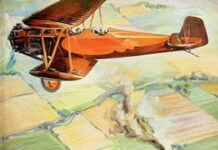1929 was a year of mixed fortunes. There was a flurry of passenger airliner crashes in the midst of rapidly increasing demand. A connection could be argued with a temptation to cut corners in a year of distance and speed records. Perhaps the real winners were a new generation of high wing monoplanes, though.
Meanwhile, major protagonists in a future World War II upped the ante with larger, faster and more sophisticated warplanes. Germany, France and Great Britain were major players, with the United States seemingly more interested in personal aircraft.
However, the power was not yet solely in the hands of the military, and private corporations. There was still space in history for a light aircraft you could build yourself, and a helicopter rotor without a motor that added lift to its host airplane. Perhaps the most exciting though, was a passenger airplane offering luxury comparable with transatlantic airliners.
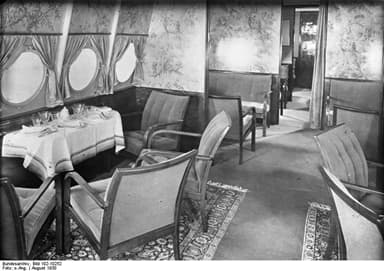
https://en.wikipedia.org/wiki/File:Bundesarchiv_Bild_102-10252,_Flugschiff_Dornier_Do_X,_Speiseraum.jpg
JANUARY 1929
Poland creates LOT Polish Airlines as a state-owned, self-governing corporation.
Carl Spaatz and four other United States Army Air Corps pilots remain aloft in the modified Atlantic-Fokker C-2A Question Mark and set an endurance record of 151 hours
British Gloster Gauntlet Single Seat Biplane Fighter Aircraft
The Gloster Gauntlet was the last Royal Air Force fighter to have an open cockpit, and the second-last biplane fighter in service. A new construction method made it easier to build, and enabled a total 246 aircraft after the maiden flight of the S.S.19 prototype in January 1929.

https://en.wikipedia.org/wiki/File:Gloster_F.926.jpg
The Gloster Gauntlet was a development of the Gloster S.S.19B design, which originally mounted six machine guns (four in the wings and two in the fuselage). It proved successful and popular in operational service, being 56 mph faster than the Bristol Bulldog it replaced, and formed the main part of the RAF’s fighter squadron strength.
The specification of the Gauntlet Mk II entering service in May 1936 was as follows:
- Length 26.6 ft, height 10.5 ft, wing span 32.5 ft, wing area 315 sq ft
- Empty weight 2,770 lb, gross weight 3,970 lb, crew one
- Bristol Mercury VI S2 9-cylinder air-cooled radial piston engine, 645 hp
- Max 230 mph, range 460 mi, ceiling 33,500 ft, climb to 20,000 ft in 9 min
- Two forward facing 0.303 inch Vickers machine guns
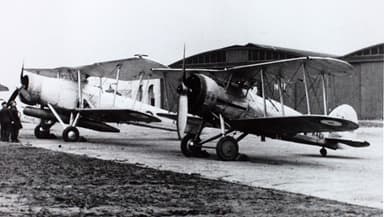
https://commons.wikimedia.org/wiki/File:15_Gloster_Gauntlet_Mk_I_in_the_foreground_with_a_Fairey_Swordfish_(15650662517).jpg
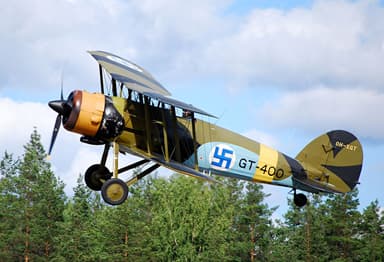
https://en.wikipedia.org/wiki/File:OH-XGT_at_EFSE_20080802_05.jpg
FEBRUARY 1929
Americans Frank Hawks and Oscar Grubb set a continental United States record while ferrying a Lockheed Air Express from the factory in Burbank, California to an air show in New York City. The flight takes 18 hours 21 minutes.
Americans Henry Berliner and Temple Nach Joyce found the Berliner-Joyce Aircraft Corporation.
American Bellanca CH-300 Pacemaker Six-Seat Utility Aircraft
The Bellanca CH-300 Pacemaker became renowned for its long-distance endurance, and was readily recognized by the flying struts supporting the high monoplane single wings. It captured public imagination in February 1929, when George William Haldeman and mechanic James F. Hayden made the first nonstop flight between Canada and Cuba.
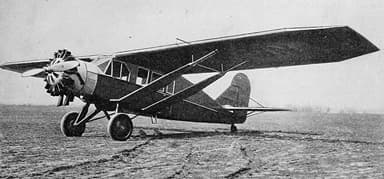
https://commons.wikimedia.org/wiki/File:Bellanca_CH-300_Pacemaker_Aero_Digest_March,1930.jpg
The Bellanca CH-300 Pacemaker was a faster, more powerful version of the Bellanca CH-200, and continued its reliable legend. The brand became renowned for its long-distance capabilities, as well as reliability and weight-lifting attributes which contributed to its successful operation throughout the world.
They were particularly popular in Alaska, and the Canadian bush where their rugged reliability was much in demand. The Royal Canadian Air Force purchased six from Canadian Vickers in Montreal mainly for aerial photography. This stands as a tribute to their steadiness and predictability.
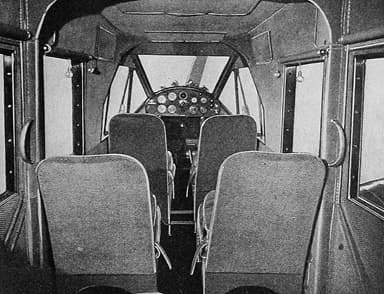
https://commons.wikimedia.org/wiki/File:Bellanca_Pacemaker_cabin_Aero_Digest_January,1930.jpg
The specification of the Bellanca CH-300 Pacemaker was as follows:
- Length 27.5 ft, height 8.5 ft, wing span 46.4 ft, wing area unknown
- Empty weight 2,275 lb, gross weight 4,072 lb, crew one, five passengers
- Wright J-6 supercharged radial engine, 330 hp, max 165 mph, range 675 mi
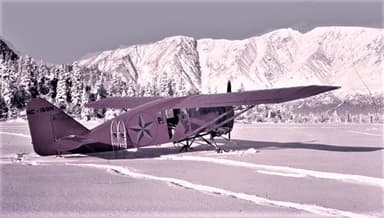
https://commons.wikimedia.org/wiki/File:Star_Bellanca_CH-300_Pacemaker_in_snow.jpg
https://commons.wikimedia.org/wiki/File:CF-ATN_Bellanca_CH.300_Pacemaker_(7637431760).jpg
German Junkers A50 Low Wing Mono Sports Plane
The Junkers A50 once again demonstrated how far ahead the company was in terms of aviation design. The first prototype flew on February 13, 1929, but four more followed to test different engines. Junkers originally hoped to sell 5,000. However, the high cost of technology meant only 69 were sold in the end.

https://commons.wikimedia.org/wiki/File:Junkers_A_50_Junior_left_rear_L%27A%C3%A9ronautique_July,1929.jpg
The Junkers A50 was a metal construction sports plane, with low cantilever wings, and stressed corrugated duralumin cladding. The two-spar wings folded rearwards for ease of storage, or could be completely detached. The pilot and passenger sat in tandem, separate cockpits.
Three German A50s took part in the July 1929 Challenge International touring plane competition, but only fared moderately well. However, a floatplane version established a series of eight world records for altitude, range and average speed in June 1930.
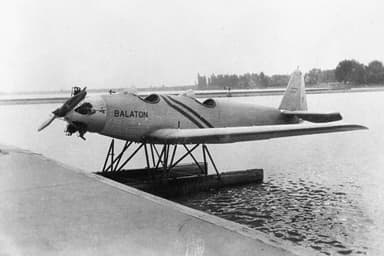
https://commons.wikimedia.org/wiki/File:Junkers_A-50_Junior_hidropl%C3%A1n_kik%C3%A9pz%C5%91_rep%C3%BCl%C5%91g%C3%A9p_a_Balatonon._Fortepan_25254.jpg
The specification of the Junker A50ba was as follows:
- Length 23.5 ft, height 7.5 ft, wing span 32.5 ft, wing area 147 sq ft
- Empty weight 750 lb, gross weight 1,301 lb, crew one, one passenger
- Armstrong Siddeley Genet II 5-cylinder air-cooled radial piston engine, 87 hp
- Max 102 mph, cruise 87 mph, range 370 mi, ceiling 13,800 ft, 9,800 ft / 21 min
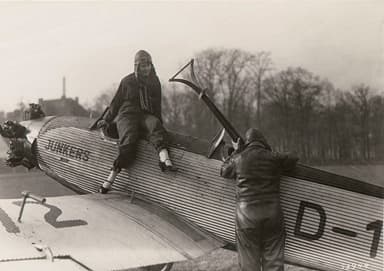
https://commons.wikimedia.org/wiki/File:Aviator_with_Junkers_Juinor_sports_plane.jpg
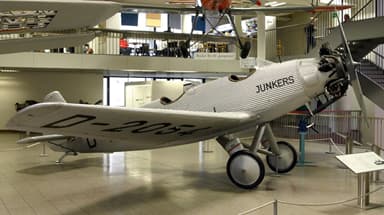
https://en.wikipedia.org/wiki/Junkers_A50#/media/File:Junkers-a50.jpg
MARCH 1929
Spain merges Iberia and several other airlines to form the Spanish government airline CLASSA.
Both engines fail on a Colonial Western Airways Ford 4-AT-B Trimotor during initial climb. It crashes into a heavily laden railroad freight car, killing 14 of the 15 people on board the aircraft. This was the deadliest airplane accident in American history to date.
A five-day-old Ford 5-AT-B Trimotor crashes when one wing hits the ground during pre-delivery testing. All four people on board the aircraft perish.
Imperial Airways begins the first scheduled air service between the United Kingdom and British India.
French Levasseur PL.10 Carrier-Based Reconnaissance Aircraft
The Levasseur PL.10 was a carrier-based biplane made for the water as opposed to having a pair of floats tacked on. It first flew in the spring of 1929, whereafter 69 were built in two batches for the French Naval Aviation Division, with the second group replacing the first with improved technology.
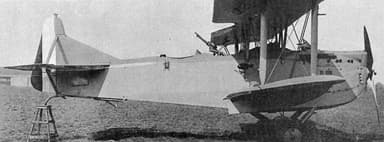
https://commons.wikimedia.org/wiki/File:Levasseur_PL.10_L%27A%C3%A9ronautique_July,1929.jpg
The Levasseur PL.10 featured a number of ‘made-for-ditching’ features. These included a watertight, boat-shaped fuselage, small underwing floats, and undercarriage that could be jettisoned in flight, in order to improve the prospects of a successful emergency landing.
Other than that, it was a conventional, single-bay biplane, along similar lines to Levasseur’s other contemporary designs. The later, PL.107 shipborne torpedo bomber featured a fully enclosed cockpit, which also enclosed the mounting between the fuselage and upper wing, although the French Naval Aviation Division turned it down.
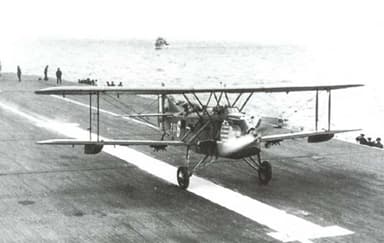
https://en.wikipedia.org/wiki/File:Levasseur_PL_101_Appontage.jpg
The specification of the Levasseur PL.10 was as follows:
- Length 32 ft, height 12.5 ft, wing span 46.5 ft, wing area 611 sq ft
- Empty weight 4,440 lb, gross weight 6,930 lb, crew three
- Hispano-Suiza 12Lb , twelve-cylinder, 600 hp engine
- Mac speed 140 mph, cruise 80 mph, range 375 mi, ceiling 4,500 ft
- One fixed, forward-firing machine gun
- One trainable, rearward-firing machine gun, 132 pound weight of bombs
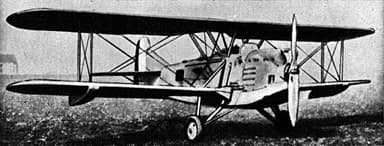
https://commons.wikimedia.org/wiki/File:Levasseur_PL.101.jpg
APRIL 1929
A United States Army Air Corps Boeing PW-9D fighter attempts to pass in front of a Maddux Air Lines Ford 5-AT-B Trimotor which is on a scheduled passenger flight. It collides with the Trimotor’s cockpit killing the PW-9D pilot, and all five people aboard the passenger airliner.
Two British Royal Air Force pilots complete the first non-stop flight from the United Kingdom to British India, using a Fairey Long-Range Monoplane. They cover 4,130 miles in 50 hours 48 minutes. But this is 336 miles short of the world nonstop flight distance record.
MAY 1929
A German, Friedrich W. Neuenhofen sets a new world altitude record, reaching 41,794 feet in a Junkers W 34 be/b3e.
American Pietenpol Air Camper with Ford Model A Engine
Bernard H. Pietenpol flew the Pietenpol Air Camper prototype in 1928, with a view to creating a plane that was affordable and easy to construct for home DIY enthusiasts. However, people only started purchasing plans in numbers after he modified the fuselage to accept a cheaper Ford Model A Engine.
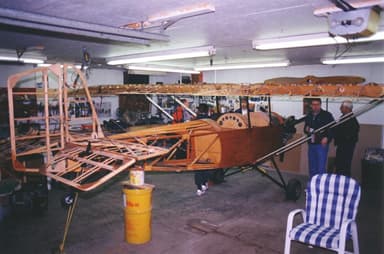
https://commons.wikimedia.org/wiki/File:PietenpolAirCamperUncovered.JPG
Customers bold enough to tackle the project needed basic woodworking skills, and tools. They also needed to be able to fabricate metal fittings to join the wooden parts together, and they needed basic welding skills too. Available records suggest over 50 projects were completed. One restored example is at the Mid-Atlantic Air Museum in Reading, Pennsylvania.
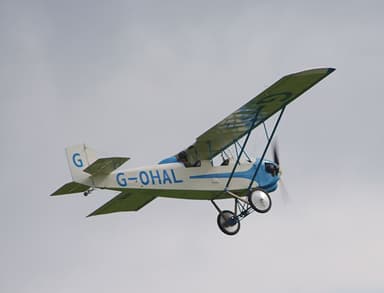
https://commons.wikimedia.org/wiki/File:Air_Camper_2008.jpg
- Length 17.5 ft, height 6.5 ft, wing span 29 ft, wing area 135 sq ft
- Empty weight 610 lb, gross weight 95 lb, crew one, one passenger
- Ford Model A automotive conversion engine, 40 hp
- Max speed 100 mph, stall speed 35 mph, climb rate 500 ft / min
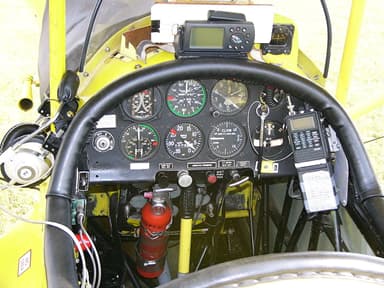
https://commons.wikimedia.org/wiki/File:PIETENPOL_AIRCAMPER_GN_1_C-GFCU_instrument_panel.JPG
American Granville Gee Bee Model A Two-seat Biplane
The Gee Bee Model A was Granville Brothers first aircraft, and they clearly had the leisure and training markets in mind. Therefore it had to be relatively inexpensive, safe and reliable in the air, and able to absorb rough landings. It would have probably sold well too, had it not been for the shockwaves of the Great Depression.

https://upload.wikimedia.org/wikipedia/commons/f/f3/Gee_Bee_Model_A_3086.jpg
The side-by-side two-seater cockpit with twin headrests was one of many novel ideas. As were the breakaway universal joints on the undercarriage outrigger,designed to shear off in an accident without damaging the fuselage. And they proved their worth on at least one occasion when a snowstorm blind-sided a pilot.
The first proving flight took place on May 3, 1929. From the beginning, the brothers insisted the Model A be able to accept both skis and floats, so that they could use it on extended family holidays. The Granville Gee Bee Model A may not have won any competitions, but it was fun to fly and it did its job well.
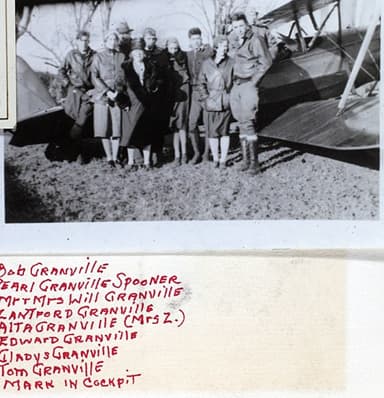
https://commons.wikimedia.org/wiki/File:Granville_clan_with_Gee_Bee_Model_A.jpg
The specification of the Granville Gee Bee Model A was as follows:
- Length 20.5 ft, height 8.5 ft, upper wing span 29 ft, wing area 185 sq ft
- Empty weight 1,060 lb, gross weight 1,650 lb, crew one, one passenger
- Main production engine Kinner K-5 5-cylinder air-cooled radial engine, 118 hp
- Max 108 mph, cruise 92 mph, range 400 mi, ceiling 11,000 ft, climb 5,100 ft / 10 min
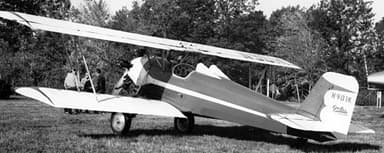
https://en.wikipedia.org/wiki/File:AL61A-346_Gee_Bee_Model_A_N901K_(cropped).jpg
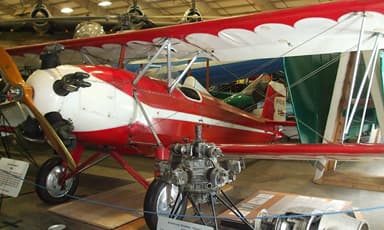
https://en.wikipedia.org/wiki/Granville_Gee_Bee_Model_A#/media/File:GEEBEE-A_(cropped).JPG
JUNE 1929
Thirty-five Italian seaplanes make a 3,300-mile, mass-formation flight. They stop at Taranto, Italy; Athens, Greece; Istanbul, Turkey; Varna, Bulgaria; Odessa in the Soviet Union; and Constanta, Romania. The aircraft include 32 Savoia-Marchetti S.55s, two Savoia-Marchetti S.59s, and one CANT 22.
An Imperial Airways Handley Page W.10 suffers an engine failure and ditches in the English Channel in summer. Seven of the 13 people aboard die. A Belgian fishing trawler rescues the six survivors, all of whom are injured.
A Spanish air force crew attempts a westward flight around the world in a Dornier Do J Wal flying boat They overshoot their first, island stop, run out of fuel and ditch in the ocean. They drift for seven days before a British aircraft carrier rescues them.
American companies Curtiss Aeroplane and Motor Company, and Wright Aeronautical Corporation merge to form the Curtiss-Wright Corporation.
British Cierva C.19 Two Seat Autogyro Fixed Wing Aircraft
The Cierva C.19 just makes it into the fixed wing category, because it was a hybrid monoplane as opposed to a helicopter with a pair of wings. It was built by Avro as the Type 20, and went on to become one of Spanish engineer Juan de la Cierva’s most successful and widely produced designs.
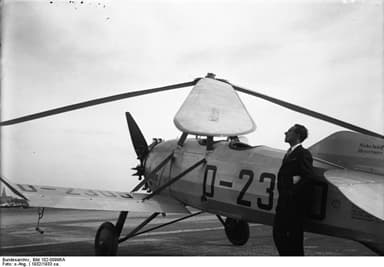
https://en.wikipedia.org/wiki/File:Bundesarchiv_Bild_102-00996A,_Hubschrauber_Focke-Wulf_C_19_%22Heuschrecke%22.jpg
The Cierva C.19 had a conventional airframe, a two-seat fuselage carrying a small-span wing with ailerons to relieve rotor loads in level forward flight, and a single radial engine in the nose.
The unpowered, passive free-spinning rotor had three, alternatively four wire-braced blades. It had to be started by hand, or by pulling a rope unless there was space for a take-off run. In so doing it provided the lift, while the single radial engine in the nose was the sole motive power
Some thirty examples were built after the first flight in mid-1929. Fifteen were on the British civil register. Other machines were registered in Australia, Germany, Japan, New Zealand, Singapore, Spain, and Sweden.
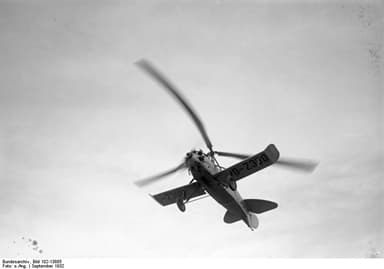
https://en.wikipedia.org/wiki/File:Bundesarchiv_Bild_102-13885,_Hubschrauber_Focke-Wulf_C_19_%22Heuschrecke%22.jpg
The specification of the Cierva C.19 Mk.II was as follows:
- Length 18 ft, height 10 ft, main rotor diameter 30 ft, wing area 708 sq ft
- Empty weight 850 lb, gross weight 1,400 lb, crew one, one passenger
- Armstrong Siddeley Genet Major 1 five-cylinder radial engine, 105 hp
- Max speed 95 mph, range 300 mi, rate of climb 500 ft / min
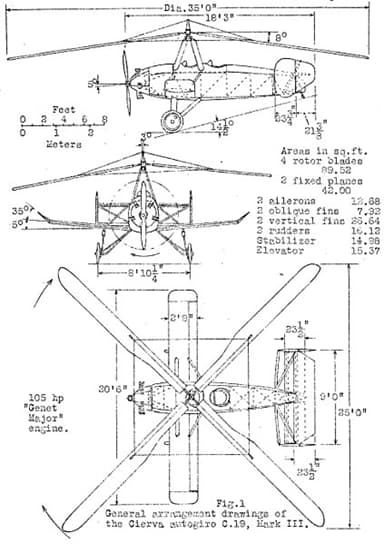
https://en.wikipedia.org/wiki/File:Cierva_C.19_Mk.III_3-view_NACA_Aircraft_Circular_No.120.jpg

https://commons.wikimedia.org/wiki/File:Autogiro_Cierva_C.19.jpg
JULY 1929
American Transcontinental Air Transport starts a regular service transporting passengers all the way across the United States in 48 hours. However, the company uses a combination of trains and aircraft for different legs of the journey.
German Deutsche Luft Hansa airline uses a catapult to launch a Heinkel He 12 mail plane from the passenger liner Bremen 248 miles out of New York, New York. The mail is on its way before the ship reaches port.
British Saro A17 Cutty Sark Amphibious Monoplane Aircraft
The A17 Cutty Sark was built by Saunders-Roe (Saro) as its first project on the Isle of Wight, immediately south of England. This was shortly after Sir Alliot Verdon Roe sold Avro aircraft manufacturers, and acquired a share. It first flew on Jul 4, 1929 and sparked immediate interest.

https://en.wikipedia.org/wiki/File:Saro_Cutty-Sark.jpg
The Saro A17 was a shoulder-winged, twin-engine four-seat amphibian monoplane with an all-metal hull, and plywood covered wings. The elevated position of the engines kept them clear of water spray when taking off and landing. Engineers appreciated the pylon mounts because they facilitated engine changes.
Some 12 A17 Cutty Sark’s were sold, including to the military in China, Dominican Republic, New Zealand, and the United Kingdom. Unfortunately, their top-heavy design guaranteed some had short service lives after being driven ashore by gusts of wind. The relatively unspectacular performance may also have contributed to low sales.

http://www.ukairfieldguide.net/airfields/Cowes-Somerton
The specification of the A.17 M with Genet engines was as follows;
- Length 34.5 ft, height 11 ft, wing span 45 ft, wing area 320 sq ft
- Empty weight 2,725 lb, gross 3,865 lb, crew two, two passengers / 510 lb payload
- Two Armstrong-Siddeley Genet Major 7-cylinder radial piston engines, 140 hp each
- Max 107 mph, cruise 93 mph, range 315 mi, ceiling 9,000 ft, climb 500 ft / min
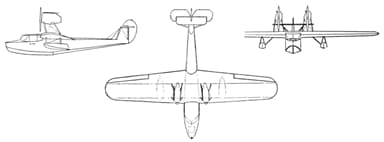
https://en.wikipedia.org/wiki/File:Saunders_Roe_Cutty_Sark_3-view_L%27A%C3%A9ronautique_August,1929.png
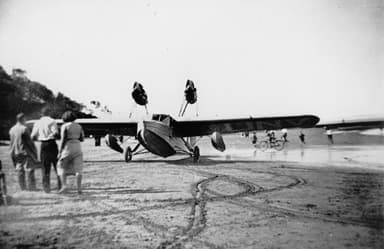
https://commons.wikimedia.org/wiki/File:StateLibQld_2_188179_Saro_Cutty_Sark_amphibious_plane_at_Redcliffe,_1937.jpg
German Dornier Do X Semi Cantilever Monoplane
The Dornier Do X was the largest, heaviest, and most powerful flying boat in the world, when it first flew on July 12, 1929 after four years in development. The passenger accommodation was luxurious even by transatlantic standards. The flight deck bore a strong resemblance to the bridge of a vessel.
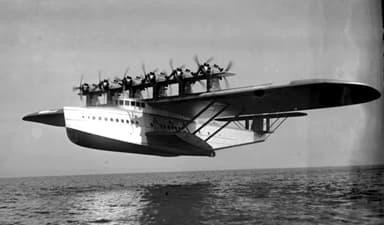
https://en.wikipedia.org/wiki/File:Bundesarchiv_Bild_102-12963,_Flugboot_%22Do_X%22.jpg
The Dornier Do X had an all-duralumin hull, with wings composed of a steel-reinforced duralumin framework covered in heavy linen fabric and aluminum paint. Six tractor propeller engines, and six pushers mounted on six strut-mounted nacelles above the wing.
There were three decks in the accommodation. The main deck was a smoking room with its own wet bar, a dining salon, and seating for 66 passengers, which could also be converted to sleeping berths for night flights.
The cockpit, navigational office, engine control and radio rooms were on the upper deck. While the lower deck held fuel tanks and nine watertight compartments, only seven of which were needed to provide full flotation. Only three of the giant aircraft were built, due to a lack of commercial interest.
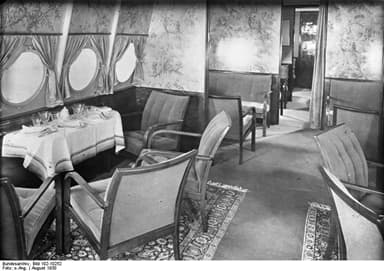
https://en.wikipedia.org/wiki/File:Bundesarchiv_Bild_102-10252,_Flugschiff_Dornier_Do_X,_Speiseraum.jpg
The specification of the Do X1a was as follows:
- Length 131.5 ft, height 33.5 ft, wing span 157 ft, wing area 5,233 sq ft
- Empty weight 61,729 lb, gross weight 108,027 lb, crew 10, 66 passengers
- Twelve Siemens Jupiter 9-cylinder air-cooled radial piston engines, 525 hp each
- Max 150 mph, cruise 110 mph, range 1,100 mi, service ceiling 10,500 ft

https://commons.wikimedia.org/wiki/File:Bundesarchiv_Bild_102-10658,_Flugschiff_Dornier_%22Do_X%22,_Maschinenzentrale.jpg

https://commons.wikimedia.org/wiki/File:Do-X_Landung_2_Havarie.JPG
AUGUST 1929
The first International Tourist Aircraft Contest, Challenge 1929 plays out in Paris. German Fritz Morzik and crew win the 3,692 mile race over Europe in a BFW M.23 plane.
French Potez 36 Two-Seat Touring / Sport Monoplane
Legend has it the Potez 36 emerged after an ‘English Lord’ complained there were no comfortable and safe private planes. Whatever the case, more than 300 customers wanted one after the first flight in August 1929. And by all accounts it had creature comforts that put it somewhat ahead of the pack.
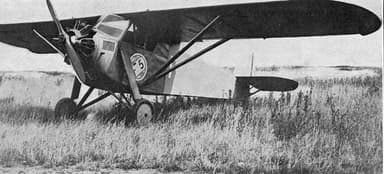
https://commons.wikimedia.org/wiki/File:Potez_36_with_95hp_Salmson_engine_L%27A%C3%A9ronautique_August,1929.jpg
The Potez 36 was a high-wing, braced monoplane with conventional landing gear, and followed the same mixed-construction method as its predecessor the Potez 35 twin-engine bomber.
However, the design varied in several ways as a concession to private owners. The Potez 36 had folding wings to make it easier to store in a garage or to tow behind a motor car.
The pilot and passenger sat side-by-side in the enclosed cabin. The Potez 36 was popular with private owners and clubs. The French army also used it as a scout / liaison aircraft during the 1930s.
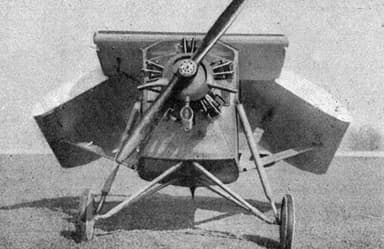
https://commons.wikimedia.org/wiki/File:Potez_36_folded_wings_L%27A%C3%A9ronautique_May,1929.jpg
The specification of the Potez 36/3 was as follows:
- Length 24.5 ft, height 8 ft, wing span 10.5 ft, wing area 215 sq ft
- Empty weight 941 lb, gross weight 1,433 lb, crew one, one passenger
- Salmson 5Ac radial, air-cooled piston engine , 60 hp
- Max speed 93 mph, range 500 mi, service ceiling 11,810 ft
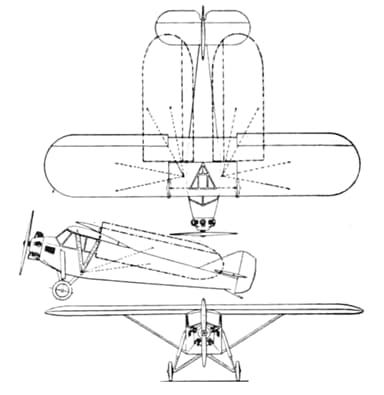
https://en.wikipedia.org/wiki/File:Potez_36_3-view_Aero_Digest_December_1929.png
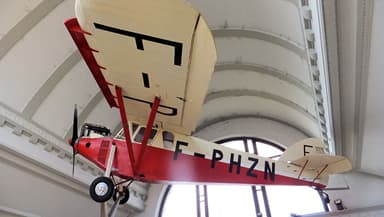
https://en.wikipedia.org/wiki/Potez_36#/media/File:ALBERT_-_GARE_-_Avion_POTEZ_-_6906.JPG
SEPTEMBER 1929
A Transcontinental Air Transport Ford 5-AT-B Trimotor strikes Mount Taylor near Grants, New Mexico during a thunderstorm, killing all eight people on board.
An Imperial Airways de Havilland DH.66 Hercules crashes when it flares too early while attempting a night landing at Jask Airport in Persia. It bursts into flames when its wing fuel tanks rupture and emergency flares in its wingtips ignite the fuel. Both crew members and one of the three passengers die.
British Royal Air Force Flying Officer Henry Waghorn wins the 1929 Schneider Trophy race in a Supermarine S.6. He achieves an average speed of 328 mph at Calshot Spit, United Kingdom.
United States Navy Lieutenant Apollo Soucek sets a world altitude record for seaplanes, climbing to 38,500 feet in a Wright XF3W-1 Apache equipped with floats.
Frenchmen Dieudonné Costes and Maurice Bellonte set a new world distance record of 4,909 miles from Le Bourget, Paris, France, to Qiqihar, Manchuria, China, in a Breguet 19.
German Fritz von Opel pilots the rocket-powered RAK.1 aircraft on a 75-second, one mile flight near Frankfurt-am-Main, Germany.
British De Havilland DH.80A Puss Moth Three Seater Monoplane
The De Havilland DH.80A Puss Moth was one of the highest-performance private aircraft of its era, being able to exceed 120 mph. It was designed for the flourishing private flying movement in the United Kingdom. And orders came quickly from private buyers after the prototype flight on September 9, 1929.
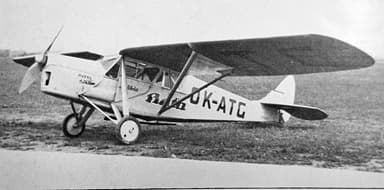
https://commons.wikimedia.org/wiki/File:Walter_Junior_4_a_De_Havilland_DH-80_A_Puss_Moth.jpg
The production model had a fabric-covered steel-tube fuselage, compared to the wooden construction of the prototype. And was as such re-designated the DH.80A to distinguish it. However, it retained the inverted inline engine that gave unimpeded vision across the nose.
Most DH.80As served as private aircraft, though some also flew commercially with small air charter firms for passenger and mail carrying. The standard version accommodated two passengers at a squeeze. The wings folded backwards for storage, pivoting on the rear spar, root and the V-strut root fitting. A few survived into the early 21st century.
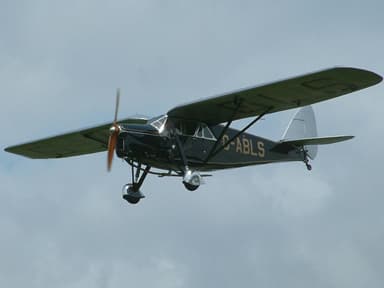
https://en.wikipedia.org/wiki/File:G-abls.jpg
The specification of the prototype De Havilland DH.80 was as follows:
- Length 25 ft, height 7 ft, wing span 36.5 ft, wing area 222 sq ft
- Empty weight 1,265 lb, gross weight 2,050 lb, crew one, two passengers
- De Havilland Gipsy III 4-cylinder air-cooled inverted piston engine, 120 hp
- Max 128 mph, range 300 mi, service ceiling 17,500 ft, climb 630 ft / min
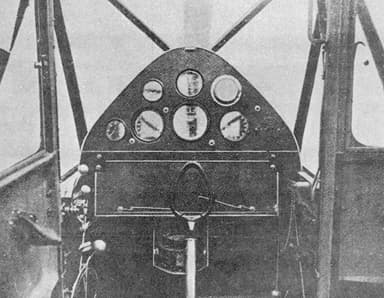
https://commons.wikimedia.org/wiki/File:De_Havilland_Puss_Moth_cockpit_NACA_Aircraft_Circular_No.117.jpg
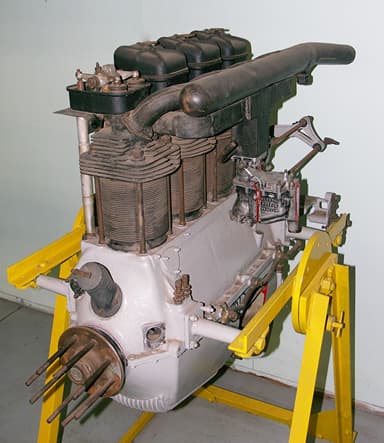
OCTOBER 1929
United States Naval Air Station Glenview in Illinois is dedicated, and its hangar was deemed the largest in the world. There were many innovations including a loudspeaker system that informed the passengers of flight arrivals and departures.
An Imperial Airways Short S.8/1 Calcutta flying boat makes a forced landing in high winds and poor weather in the Ligurian Sea off La Spezia, Italy. It sinks during efforts to tow it to shore, killing all seven people on board.
Black Thursday strikes heralding the Great Depression. This will have an immeasurable effect on aviation development.
Soviet Tupolev ANT-7 Reconnaissance Aircraft and Escort Fighter
The Tupolev ANT-7 (also known as Tupolev R-6) met the Soviet need for a long-range, multirole aircraft in the early 1930s. This included using it for long-range transport, defensive patrolling, reconnaissance, light bombing and torpedo attacks. The first flight of the multi-role aircraft was on October 20, 1929.

https://www.globalsecurity.org/military/world/russia/ant-7.htm
The Tupolev ANT-7 was a one third scaled down version of the Tupolev TB-1 bomber. The first production models rolled off the line in 1931, and a total 411 were produced over the next three years.
The standard version had a pilot, gunner and observer, and was able to carry 250 pounds weight of bombs. One variation had floats for maritime duties. Another had two machine guns and a second gunner. Several were converted to passenger / cargo aircraft after they became militarily obsolete by 1935.

https://www.globalsecurity.org/military/world/russia/ant-7.htm
The specification of the Tupolev ANT-7 / Tupolev R-6 was as follows:
- Length 49.5 ft, height unknown, wing span 76 ft, wing area 860 sq ft
- Empty weight 8,501 lb, gross weight 14,268 lb, pilot and three crew
- Two Mikulin M-17F V-12 water-cooled piston engines, 720 hp each
- Max speed 140 mph, range 500 mi, ceiling 18,440 ft, climb 530 ft / min
- Five 0.30 inch DA-2 light rotating cartridge machine guns
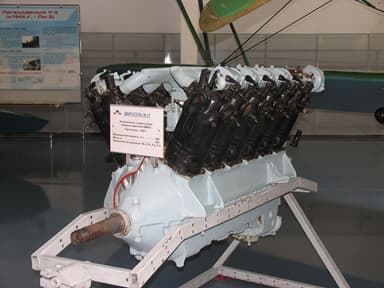
https://en.wikipedia.org/wiki/Mikulin_M-17#/media/File:Mikulin_M-17.jpg
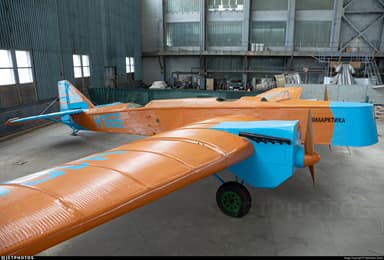
https://www.jetphotos.com/photo/9054331
American Aeronca C-2 ‘Automatically Stable’ High Wing Monoplane
Jean A Roche was a U.S. Army Engineer when he lodged a patent for ‘automatic aircraft stability’ in the early 1920’s. He set to work building the prototype Aeronca C-2 in 1923, however the first fully-successful flight was only in August 1929. The finish was exceptionally basic with the pilot’s seat a bare plywood board.
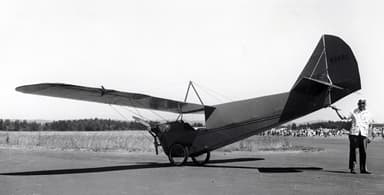
https://www.museumofflight.org/aircraft/aeronca-c-2
The production model sold 164 examples despite the Great Depression, and sparked the growth of private aviation in the United States.
The design was perhaps inspired by the Santos-Dumont Demoiselle light monoplane – that Roche flew early in his career – which had a similar triangular basic fuselage cross-section, and wire-spoked main landing gear wheels against the fuselage sides.
The instrumentation was pared back to the bare essentials, with altimeter, oil temperature, oil pressure, and tachometer dials on the dashboard. The controls comprised a stick and rudder pedals. You had to pay extra for brakes and a heater. But then the price fell from $1,555 to US$1,245 as sales volumes increased.
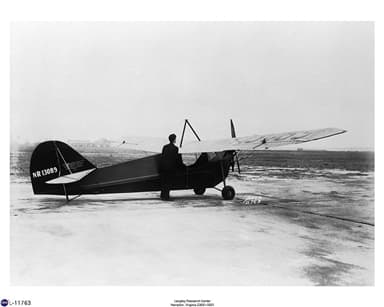
https://en.wikipedia.org/wiki/File:EL-2003-00273.jpg
The specification of the Aeronca C-2 was as follows:
- Length 20 ft, height 7.5 ft, wing span 36 ft
- Wing area 142 sq ft, empty weight 406 lb, crew one
- Aeronca E-107 1.75L flathead piston engine, 26 to 30 hp
- Max speed 80 mph, cruise 65 mph, range 240 mi, ceiling 16,000 ft

https://en.wikipedia.org/wiki/Aeronca_E-107#/media/File:Aeronca_E107.jpg
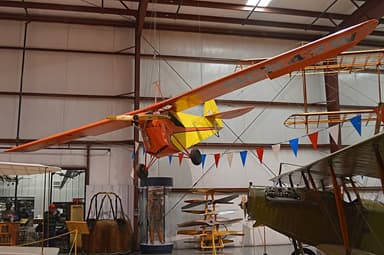
https://commons.wikimedia.org/wiki/File:Aeronca_C-2_%E2%80%98NC647W%E2%80%99_(25237686344).jpg
German Junkers G.38 Four-Engine Transport Aircraft
The Junkers G.38 conformed to standard Junkers practice with multi-tubular spar cantilever wings, covered – like the rest of the aircraft – in stressed, corrugated duralumin. The biplane tail was intended to reduce rudder forces. There were three rudders with only a central fixed fin when it first flew on November 6, 1929,
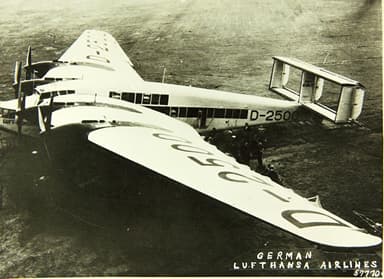
https://en.wikipedia.org/wiki/File:Junkers_G_38.jpg
However, in the end only two of the aircraft were built, possibly in deference to the Great Depression. Both aircraft flew as commercial transport within Europe in the years leading up to World War II. The design was also licenced to Mitsubishi, which produced six military bomber / transport versions designated Ki-20.
The Junkers G.38 was clearly intended for long-range travel. The crew of seven included onboard mechanics to service the engines during flight, thanks to the blended wing design.
The passenger accommodation was in the inner wings which were 5 foot 7 inches thick at the root. The leading edges provided views usually available only to pilots. There were three 11-seat cabins, plus smoking cabins and washrooms.
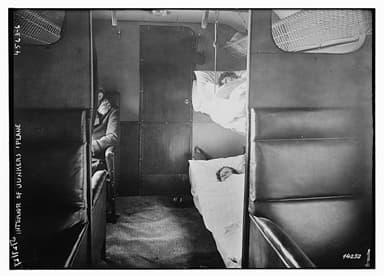
https://commons.wikimedia.org/wiki/File:Junkers_G.38_cabin_(26171388053).jpg
The specification of the 1929 Junkers G.38 was as follows:
- Length 76 ft, height 23.5 ft, wing span 144.5 ft, wing area 3,100 sq ft
- Empty weight 32,893 lb, max take-off 48,826 lb, crew seven, thirty passengers
- Two inboard Junkers L88 V-12 water-cooled diesel piston engines
- Two outboard Junkers L8a six-cylinder, water-cooled diesel piston engines
- Max speed 140 mph, cruise 109 mph, range 2,150 mi, ceiling 12,110 ft

https://commons.wikimedia.org/wiki/File:Junkers_Grossflugzeug_LA2-Blitz-0128_5.jpg
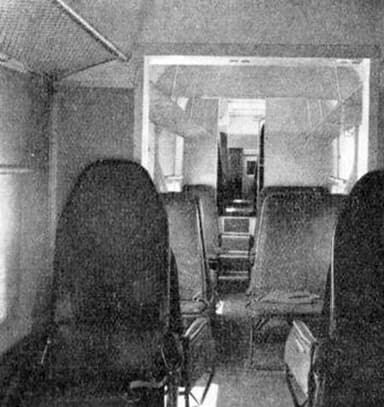
https://commons.wikimedia.org/wiki/File:Junkers_G_38_interior_L%27Aerophile_November_1932.jpg
NOVEMBER 1929
A Deutsche Luft Hansa Junkers G 24bi crashes after striking trees on a hill in Marden Park, Surrey England. It was returning after taking off and encountering thick fog. Three of the four crew members and four of the five passengers die.
A British Royal Air Force Fairey Flycatcher lands aboard the British aircraft carrier HMS Courageous, achieving the first night carrier landing by a fleet fighter.
American Richard Evelyn Byrd and his crew make the first flight over the South Pole in a Ford Trimotor.
https://en.wikipedia.org/wiki/Junkers_G.38
DECEMBER 1929
British Royal Air Force Captain Arthur G. Jones-Williams and Lieutenant Norman H. Jenkins depart from the United Kingdom in a Fairey Long-Range Monoplane in an attempt to set a new nonstop flight distance record to South Africa. The flight ends in tragedy when their plane crashes into the Atlas Mountains in French Tunisia, after 13 hours 40 minutes in the air killing them both.
Japanese Nakajima A2N (or Navy Type 90) Carrier Fighter
The Nakajima A2N was a single engine, biplane fighter built for use on aircraft carriers. It was a mixed-construction airplane with fixed tailwheel undercarriage. Some 160 aircraft in two versions were built between 1932 and 1936, after the first flight in December 1929.
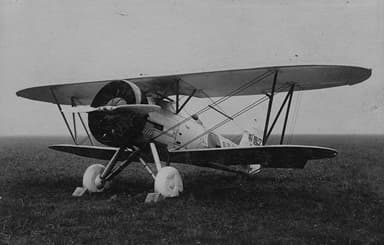
https://en.wikipedia.org/wiki/File:90siki-kansen.jpg
Nakajima Aircraft Company based their design loosely on the Boeing Model 69, and Boeing Model 100 examples, which it imported in 1928 and 1929 respectively. There was also an A3N3-1 training fighter that followed in 1936.
The aircraft stayed on in popular memory as the one in which Genda’s Flying Circus promoted naval aviation. Military versions flew from Hōshō, Kaga and Ryūjō carriers during the Second Sino-Japanese War. However they were superseded in 1937 by A4Ns and A5Ms fighters.
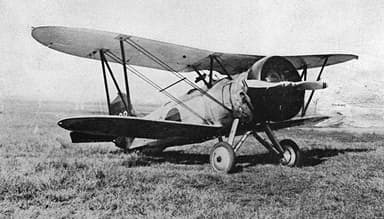
https://en.wikipedia.org/wiki/File:Nakajima_A2N3-1.jpg
The specification of the Nakajima A2N was as follows:
- Length 20 ft, height 10 ft, wing span 30.5 ft, wing area 212 sq ft
- Empty weight 2,304 lb, gross weight 3,417 lb, crew one
- Nakajima Kotobuki 2 9-cylinder air-cooled radial piston engine 460 to 580 hp
- Max 182 mph, cruise 104 mph, range 310 mi, ceiling 30,000 ft, climb 10,000 ft / 5 min
- Two forward-facing 0.303 inch machine guns for the pilot

https://commons.wikimedia.org/wiki/File:Nakajima_Type90_A2N.jpg
Japanese Mitsubishi B2M Carrier-Bases Torpedo Bomber
Mitsubishi built its Mitsubishi B2M torpedo bomber to a design by Blackburn Aircraft of Britain, and it was operated by the Imperial Japanese Navy. The original concept was submitted for a competition. The winning design was a three-seat biplane of steel tube construction with high aspect ratio wings
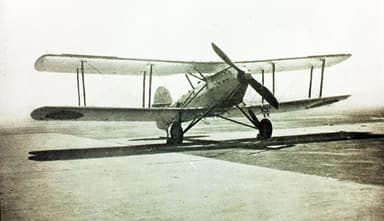
https://en.wikipedia.org/wiki/File:Mitsubishi_B2M.jpg
The original B2M1 version first flew on December 28, 1929. It entered service with the Imperial Japanese Navy in March 1932, serving aboard the carriers Akagi, Kaga and Hōshō.
Subsequent modifications to simplify maintenance resulted in the B2M2 or Navy Type 89-2 carrier attack plane. These were extensively used for high- and low-level bombing attacks against China at the start of the Second Sino-Japanese War in 1937. A total of 204 aircraft were produced including both types.
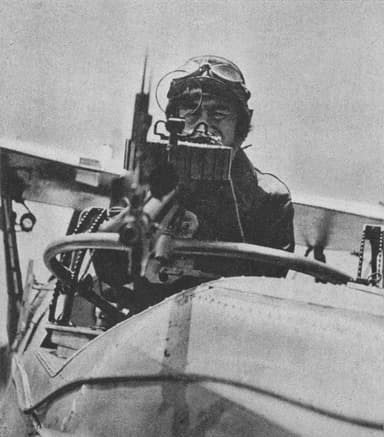
http://arawasi-wildeagles.blogspot.com/2014/04/mitsubishi-b2m-carrier-attack-bomber.html
The specification of the B2Mi aircraft was as follows:
- Length 33.5 ft, height 12 ft, wing span 50 ft, wing area 590 sq ft
- Empty weight 49,979 lb, gross weight unknown, crew three
- Hispano-Suiza 12Lbr V-12 water-cooled piston engine, 650 hp
- Max speed 132 mph, range 1,105 mi, ceiling 14,800 ft
- One forward-firing 0.303 inch machine gun for pilot
- One flexible 0.303 inch machine gun for rear gunner
- One 1,764 pound weight torpedo, or equivalent weight in bombs
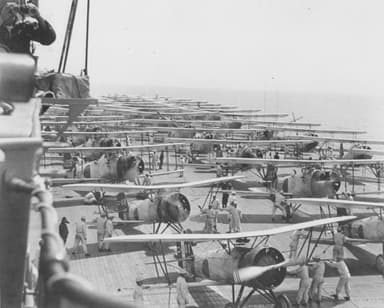
Image Link




